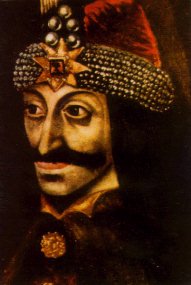

|
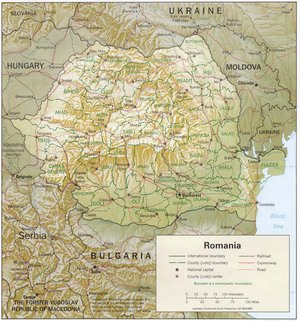 Vlad Ţepeş was a roman voivod of the XVth century, which is a kind of king. He was voivod of the Valachia which is now a part of the Romanian country.
Vlad Ţepeş was a roman voivod of the XVth century, which is a kind of king. He was voivod of the Valachia which is now a part of the Romanian country.
The Carpath montains have the shape of half a circle toward the west in the middle of what is now Romania. The inside of the half-circle is Transylvania. At the south of the Carpath, stands the Valachia.
The map shows the relief of the country. You will have to zoom in to read the names (there are a few spelling differences, see the spelling page for explainations).
The father of Vlad Ţepeş was Vlad Dracul (Vlad II). This name Dracul means Dragon (and also devil) and had been given to him because he was always wearing a bright armor with a dragon on it, sign of belonging to a special Dragon Order for bravery against Muslims.
This Dragon Order had been created in 1408 to honor and thank the bravest Christians fighting on Muslim lines. Valachia was on the border between the christian Europe and the Muslim world (Turkey). Vlad Dracul had been sent to Hungary and Germany by his father Mircea for his education.
According to Florescu and Raymond McNally's book (Dracula A price of many faces) Vlad Dracul was a bastered son of Prince Mircea and unknown mother. Prince Mircea ruled from 1386 to his death in 1418. Vlad Dracul, also known as Vlad II, was bornt around 1390. As a heir, Vlad Dracul claimed and won the throne in 1431, beeing apparently the only living man who could prove his right to the crown at this time. He ruled until 1442 then from 1443 to his death in 1447. He had three sons with a Moldovan princess: Mircea (bornt in 1430 or 1431, died at his side in 1447, burried alive by the Hungarians), Vlad (Vlad III, Vlad Draculea, later Vlad Ţepeş, bornt in 1431) and Radu (bornt 1438 or 1439, died from syphillis in 1500. He was a rival of his brother Vlad for the throne, he was quite loyal to the sultin and ruled from 1462 to 1475). Vlad Dracul left Sighişoara to Valachia when Vlad Draculea was young, and became voivode of Valachia.
Vlad Draculea was bornt in November or December 1431, in the town Sighişoara in Transylvania where his house still stands. His name means Vlad, son of Dracul, and not Son of the Devil as we can find in some articles. This is where this Dracula word comes from.
Young Vlad Draculea had a nasty adventure when his father left him as a security hostage to the Ottomans to proove his good faith.
| |||||||||||||||||||||||||||||||||||||||||||||||||||||||
During his life, Vlad Draculea had the opportunity of winning a war by putting his muslim dead enemies (turks) on pals. Maybe this way of dying was not acceptable by their religion, or because they where horrified by the forest of pals they met... he ended up with frihtened them so much that he could win the war. Turks gave him then the name Vlad Ţepeş that is still used nowodays: it means Vlad The Impaler. It surely suited him, because Vlad Ţepeş had decided to reign by fear. Many people think that he could have been inspired by the abominations which occured thousands of years earlier. The Daces were the Barbarians who first settled in Tranylvania (1st century B.C.); they were real barbarians as they used to commit savage actions. Among others, they used to sacrify young virgins on pals once a year to communicate with the god of the deads Xalmoxis. It looks like a Cthulhu story but seems true. (read more about the Daces in the following section below)
The details of his death or not certain, nor of his burials, but it seems to happen around December 1476, during a battle when he would have been murdered. His remains would have been burried in the Snagov Mânăstirea, but subsequents excavations in the 30's failed to prove it.
All his life, he never had any other kingdom than Valachia. He never was king of Transylvania. He only stepped there to fight his ennemies, specially the Sasi who were german immigrates around Braşov and Sibiu.
During his reign, he fought very hard against the enemies of Valachia, and he had a lot of political troubles with his neighbors, specially Hungary, Germany and Turkey.
About Germans, it is important to say that there were German communities settled in Valachia and Transylvania since XIIIth century, including communities around Braşov and Sibiu called Sasi. Sasi where plotting against Vlad Ţepeş because other pretenders of Valachia crown had promised them to allow free taxes path on the healthy road from Black Sea to the Balkanic Europe along the Danube.
About Hungary, we can say that Romania and Hungary were more-or-less ennemies since Xth century, when the Hungarians expelled the Huns and annexed Transylvania.
Vlad Ţepeş, for political reasons, had to reject the orthodox faith for the catholic one at the end of his life (as a matter of fact, it was the only way for him to be released from Hungarian jail in Budapest where he was in custody for 12 years).
All this combined with his severe and probably cruel personality explain why, at that time, he had the misfortune of having everyone around as enemies, from neighboring countries to all church authorities including local minorities like Germans.
This is important to emphasize, because it is the main reason of the emergeance and the survivance of the idea he was a demon, a very cruel and evil man. In all the chronicles of these times that survived till today: the turkish ones, the hungarian ones, the german ones (Sasi) and even the chronicles of the Orthodox Church, he is depicted as a very diabolical character. As these records became later the material of knowledge within scholars and historian, it is thus not surprising that his name and character became synonym of such black legends and diabolicism.
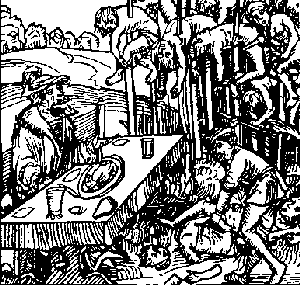 During periods of time after his death, he has been the victim of the propaganda of his political enemies. It started with the german people who printed with the famous Gutenberg machine little books about him, telling mean things about him. The image on the right is an example. It comes from german chronicles, and shows, acording to M. O. Brodoc, Vlad Ţepeş festing while impaling his ennemies. If this is true, I suppose the spot on his cheek is not a tear.
During periods of time after his death, he has been the victim of the propaganda of his political enemies. It started with the german people who printed with the famous Gutenberg machine little books about him, telling mean things about him. The image on the right is an example. It comes from german chronicles, and shows, acording to M. O. Brodoc, Vlad Ţepeş festing while impaling his ennemies. If this is true, I suppose the spot on his cheek is not a tear.
It seems that the historians of the succeeding centuries wrote their books with basis of these german folio without verifying the information, and lead to numerous historical mistakes about the character. Mistakes which survived until today.
Bram 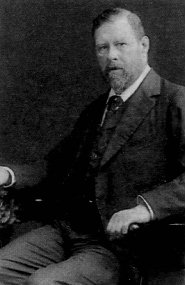 Stoker was an Irish writer and journalist (1847-1912). Even if a lot more had been said, including in this web site some time in the past, Bram Stoker knew very little about Vlad Ţepeş when he decided to use the name Dracula as a basis for his novel. Only a few notes from a book by William Wilkinson, where all these related atrocities where not mentionned.
Stoker was an Irish writer and journalist (1847-1912). Even if a lot more had been said, including in this web site some time in the past, Bram Stoker knew very little about Vlad Ţepeş when he decided to use the name Dracula as a basis for his novel. Only a few notes from a book by William Wilkinson, where all these related atrocities where not mentionned.
In a biography of him by Harry Ludlam, it is said that he was friend with Arminius Vambery, professor at the University of Bucharest, who was in London in 1890, and from that friendship Bram Stoker get details of the story of Vlad Ţepeş. But it seems however that Harry Ludlam was wrong, and that Arminius Vambery did not provided documentation about Vlad Ţepeş to Bram Stoker.
Also is not true the idea that Bram Stoker visited Romania, where he would have been inspired by the sight of Castelul Bran, in Transylvania, near Braşov, and get the idea to use Vlad Ţepeş Draculea The Impaler for a novel. I have to apologize to have been myself the bearer of these false pieces of information.
It is also worth repeating that Castelul Bran has no connexion what so ever with Vlad Ţepeş Dracula, whether in History or in Bram Stoker's novel, even if local or international tourist-oriented documents do pretend otherwise. Only the magical sight of this beautiful transylvanian well-preserved castle, prompt to enflame imagination, is responsible for the myth that it may be a Dracula's castle.
From nothing more than a footnote, without any knowledge of the alledged or exagerated atrocities of Vlad Ţepeş, Bram Stoker wrote the world-famous novel Dracula, first printed in 1897. This book is actually available on Internet.
Vlad Ţepeş was not associated with vampire things before Bram Stoker's novel. In fact, it is strange to notice that in the heart of the romanian people, Vlad Ţepeş stays a hero who fight bravely and victoriously against the enemies of his country. The dark stories about Vlad Ţepeş were in the historian's books, not in the folklor legends of the romanian people.
Most of these information are from articles and interviews of Nicolae Ariton from Tulcea (Romania), with corrections and inserts from other contributors including Elizabeth Miller. Her website includes very detailed information about Vlad Tepes, his connection with the novel, and the origin of the myth.
Vlad Ţepeş himself did not used this name to designate himself, he was using his name Vlad Draculea, bust most of the today's historian's litterature, romanian, and subsequently international, keeps refering him as Vlad Ţepeş because the name Draculea would be too negatively connoted. Although logic and historical precision would require I use today the name Vlad Draculea, I will consciously decide to stick to my original writing from 1996, based on the interviews from my Romanian source.
And here are his input :
First, for a better understanding, the usual name is either Daci, in romanian language, or Dacians. Their god was Zalmoxis. These are only translations issues.
The Dacians were not barbarians, as one imagine the true barbarian: dirty, savage and the rest.
It is true that there were some ritual sacrifices, but they were at periods of 5 years, the subjects were young males and not virgins females. The purpose of these sacrifices was to communicate with the god, and they were self-sacrifices, as the subject jumped by himself on 5 pikes, and it would had been a great shame for him to survive. Even the process of selecting these messengers was special, the young male had to be pure, never been to war, or to women, and to be known as very honest and respected individual.
You can say that this ritual is similar to the sacrifice of Isus Christos, but at a small scale.

|
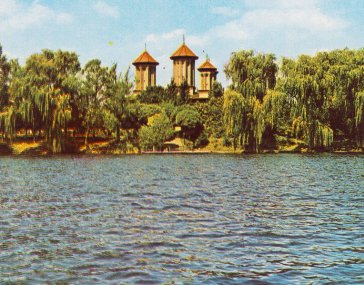
|
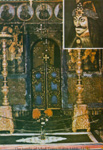
|
|
Statue of Vlad Ţepeş. I do not know how old it is. It stands in Sighişoara where Vlad Ţepeş was born and is about 1:1 scale. Some postcards show it in Braşov by mean of a photo trick. |
Insulă Snagov (Snagov Island). This is the island, in the middle of the Lacul Snagov (Snagov lake), were the Snagov Mânăstirea stands. The church one can see on the island is Biserică Neagoe Basarab (Church of Neagoe Basarab), where Vlad Ţepeş is burried. The church and the monastery are still used. This picture has been scanned from a romanian postcard of poor quality. |
Painting of Vlad Ţepeş and his tomb. This picture has been scanned from a touristic document. We can see Vlad Ţepeş at the upper right corner and a photography of his tomb in the main frame. This tomb is in the Biserică Neagoe Basarab (Snagov Mânăstirea, picture above). The picture seems quite old, a remembrance plaque and flowers have been put on the tomb since. You will find a more recent picture at the Elizabeth Miller's Dracula Homepage. This painting of Vlad Ţepeş in the upper-right corner is the same we found everywhere (including on the top of this page). I do not know when this painting has been made, nor where the original is. It is sad that we do not have other paintings of him because we thus get only one point of view on the character and so a rather basic representation of who he really was. |
File created 23rd July 1996, last update by Baptiste MARCEL, located in Asničres-sur-Seine (France).
If you enjoyed this page, please do not forget to visit my homepage.